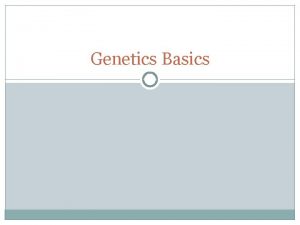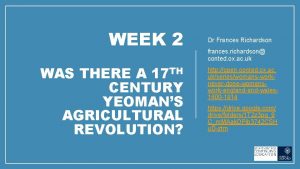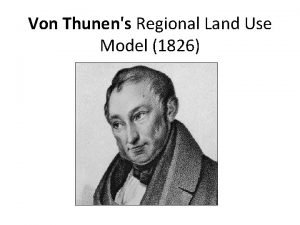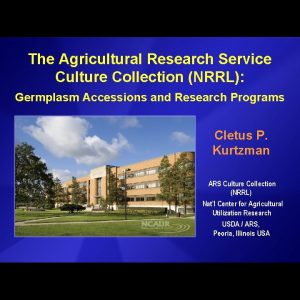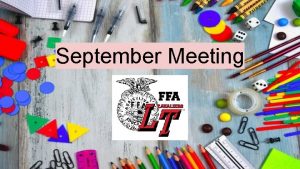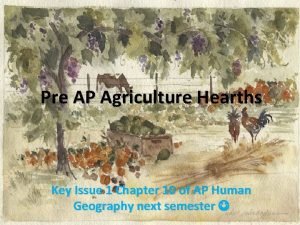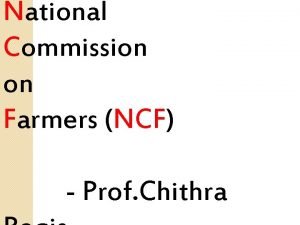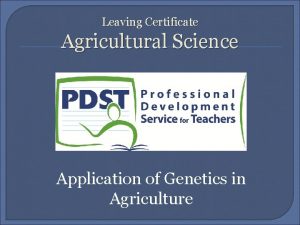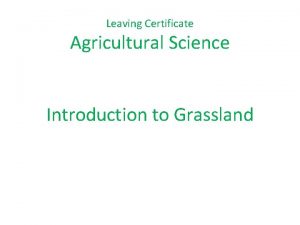Leaving Certificate Agricultural Science Genetics Introduction Introduction Genetics


















- Slides: 18

Leaving Certificate Agricultural Science Genetics - Introduction

Introduction � Genetics is the study of inheritance. � In terms of agriculture, genetics is everything. � An understanding of genetics is critical in breeding strategies in any animal enterprise and in producing new strains of barley, wheat, potatoes etc. � Most of what we know about genetics was obtained from the work of an Austrian monk called Gregor Mendel. � He used pea plants to study how characteristics were passed from one generation to the next. � Pea plants grow quickly and are self pollinating.

Genetic Definitions �A gene is a section of a chromosome that controls a specific trait. � An allele is a different form of the same gene (e. g. A gene for flower colour could have different alleles, for example for purple or white) � A locus is the location of a gene on the chromosome. � The genotype is the set of genes an individual possesses. � Dominant genes are genes that are always expressed when present. � Recessive genes are genes that are only expressed in the absence of a dominant genes. � The phenotype is the physical effect produced by the gene.

Genetic Definitions �A mutation is any change in the structure of the gene, which may be inherited. � Homologous chromosomes are pairs of chromosomes with identical genes and loci on them. � An F 1 Cross is a cross between two pure breeding parents. � Polyploidy occurs in cells containing multiple copies of a chromosome. � Heterozygous means having one dominant and one recessive gene for a characteristic (e. g. Pp) � Homozygous means having either two dominant or two recessive genes for a characteristic (e. g. PP or pp).

Genetics' Problems – Monohybrid

Genetics' Problems – Monohybrid 2

Incomplete Dominance � Mendel studied traits that were clearly dominant or recessive � In incomplete dominance, no allele is dominant and the offspring produce traits that are “in-between”. � For example, in Snapdragons, when red flowers (PP) and white flowers (pp) cross pollinate (cross fertilise), the offspring (Pp) will produce pink flowers. � Heterozygous plants, when cross-fertilised with another heterozygous, will produce red, pink and white flowers.



Mendel’s First Law � The Law of Segregation states: � Alleles of a gene exist in pairs but when gametes (sex cells) are formed the members of each pair pass into different gametes. � This means that a gamete has only one allele of each gene. � At fertilisation the offspring will have two alleles again, one from each parent.

Mendel’s Second Law � The Law of Independent Assortment state: � At Gamete formation, the separation of one pair of alleles is completely independent to the separation of all other alleles. � Example: � If we look at an organism with two genes e. g. Aa. Bb, each of the A’s can join with either of the B’s at gamete formation. � Thus we can have four gametes: AB, Ab, a. B and ab.




Sex Determination � In human, all cells (except gametes) contain 23 pairs (46) chromosomes. � 44 of these are called autosomes, which means are found in both males and females. � The other 2 are called X and Y, and their presence determine male or female. � An individual with XX would be female, while XY male.

Sex Determination - 2 � It must be noted that the Y chromosome is missing some of the genes of the X chromosome. � Examples include colour vision, blood clotting and muscle development. � These traits are said to be X linked or Sex Linked


Genetic Study Using Fruit Flies � Fruit flies or Drosophila are used to study genetics today. � Fruit flies are suitable because: � They are easy to grow. � They reproduce a new set of offspring in just two weeks. � They have large chromosomes. � They have only four chromosomes. � They produce in large numbers.
 History leaving cert syllabus
History leaving cert syllabus Primary leaving certificate
Primary leaving certificate Leaving certificate
Leaving certificate My favourite subject is maths
My favourite subject is maths Sciencefusion think central
Sciencefusion think central Cs.princeton.edu
Cs.princeton.edu An introduction to mendelian genetics
An introduction to mendelian genetics The agricultural revolution
The agricultural revolution Von thunen agricultural model
Von thunen agricultural model Von thunen 1826
Von thunen 1826 Paris basin map
Paris basin map Chester agricultural center
Chester agricultural center Nrrl culture collection
Nrrl culture collection Ffa brotherhood
Ffa brotherhood Qingdao agricultural university
Qingdao agricultural university Hearths of agriculture
Hearths of agriculture Is the component of agricultural renewal action plan
Is the component of agricultural renewal action plan Brotherhood ffa
Brotherhood ffa Agricultural revolution inventions
Agricultural revolution inventions






